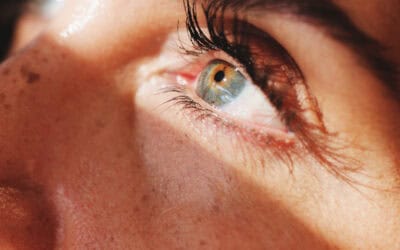That throbbing pain behind your eyes feels unmistakably connected to hours spent staring at screens or reading fine print. Most people automatically assume their headaches stem from eye strain, but this widespread belief isn’t supported by medical evidence. Eye strain headaches do exist, yet they account for far fewer head pain episodes than most people realize.
It is tension headaches, and not eye strain, that causes the majority of head pain in America. These headaches affect millions of people and can persist anywhere from 20 minutes to several hours. Your headache may seem to originate from tired, overworked eyes, but the actual source often lies elsewhere entirely.
Most headaches have nothing to do with your vision.
Research reveals that eye strain rarely triggers genuine head pain. Extended screen time, detailed reading, or close-up crafts can certainly produce familiar symptoms such as aching around your eyes, blurred vision, and occasional double vision. However, headaches rank among the most frequent complaints across all age groups, with causes that extend far beyond visual fatigue.
The trigeminal nerve carries sensations from your face directly to your brain and plays a significant role in nearly all migraine episodes and various other headache types. When this nerve activates, pain can seem to come from your eyes even when the true trigger lies elsewhere.
Your body sends specific signals when something needs attention. Learning to interpret these messages accurately determines whether you’ll find lasting relief or continue struggling with recurring pain. This guide will help you distinguish between actual eye strain headaches and other causes, understand what triggers genuine vision-related head pain, and discover targeted treatments that address the real problem—so you can stop guessing and start healing.
The Truth About Your Head Pain
That persistent ache behind your eyes probably isn’t what you think it is. Eye strain causes surprisingly few headaches, despite widespread belief otherwise. Your weekend computer marathon or evening reading session may seem like the obvious culprit, but medical evidence points elsewhere for most head pain episodes.
Understanding where your headache actually originates makes the difference between finding real relief and continuing to treat the wrong problem.
How doctors categorize head pain
Medical professionals divide headaches into two distinct categories that reveal their true nature. Primary headaches develop on their own without any underlying medical condition triggering them. These include:
- Tension-type headaches (affecting the most people)
- Migraines
- Cluster headaches
- New daily persistent headaches (NDPH)
Primary headache disorders rarely connect to vision problems. Your eyes aren’t causing these episodes, which explains why adjusting your glasses prescription or trying vision therapy typically fails to help.
Secondary headaches tell an entirely different story. These serve as warning signals of another condition affecting your body. The underlying cause might be relatively minor like dehydration or more serious conditions such as meningitis or brain tumors.
Most people seeking headache relief through vision corrections discover their effort may completely miss the mark as the real source may lie elsewhere in their body.
Warning signs that point beyond your eyes
Several clear indicators reveal when something other than visual fatigue triggers your head pain:
- Headaches that greet you upon waking or jolt you awake during sleep
- Pain paired with nausea or vomiting episodes
- Head pain that follows consistent patterns regardless of whether you’ve been reading, working on screens, or resting your eyes
- Sudden, severe pain that strikes like a thunderclap
- Head pain accompanied by fever or neck stiffness
Children under school age almost never experience genuine eye strain headaches. When your headaches persist despite giving your eyes plenty of rest, or when they occur alongside symptoms like stiff neck or fever, your body may be signaling a more serious condition that needs medical evaluation.
Genuine eye strain headaches behave very differently. They develop specifically after extended visual work such as reading small print, computer tasks, or detailed handicrafts, and improve noticeably when you rest your eyes. These headaches won’t typically prevent you from normal activities or disturb your sleep.
Vision problems like astigmatism or eye muscle misalignment can contribute to eye fatigue, yet persistent headache patterns usually point to non-visual causes. When standard over-the-counter pain relievers stop providing relief, the time has come to get an accurate diagnosis through a professional medical evaluation.
The Real Eye Problems That Cause Head Pain
While most headaches don’t come from your eyes, certain vision conditions genuinely trigger head pain that you shouldn’t ignore. Recognizing these specific problems helps you understand when your aching head actually signals an underlying eye condition that needs attention.
When your eye shape works against you
Your cornea and lens should curve like a perfectly round baseball, but astigmatism creates a shape more like a football. This irregular curve forces light to bend unevenly as it enters your eye, creating the blurred vision that makes your eyes work overtime trying to focus clearly. One in three Americans lives with astigmatism, often without realizing their eyes are struggling.
Detailed tasks like reading small print, working at your computer, or threading a needle cause your eye muscles to constantly strain to compensate for this imperfect focus. This extra effort frequently shows up as headaches, particularly after extended periods of close-up work. Uncorrected farsightedness creates a similar problem, forcing your eye muscles into constant overdrive that eventually translates into head pain.
The dry eye-headache connection
Dry eyes create more than just discomfort. This condition can trigger genuine headaches through both physical irritation and nerve pathways. When your tear film can’t maintain proper moisture, your eyes develop that burning, stinging, or gritty sensation that many people recognize.
This irritation activates your trigeminal nerve, the same nerve pathway that carries migraine and headache signals to your brain. Your body responds to this chronic irritation by changing how you blink and causing you to squint unconsciously. These altered facial muscle patterns create tension that eventually develops into headache pain.
The eye doctors at Chang Eye Group are experts in treating dry eye for patients in the Pittsburgh area. Follow this link to learn more about dry eye symptoms and root causes.
The emergency that announces itself
Most glaucoma types develop silently without causing headaches, particularly the common open-angle form that gradually steals vision.
However, acute angle-closure glaucoma is very different as this medical emergency creates sudden, dramatic pressure increases when fluid can’t drain properly from your eye. The resulting pressure spike triggers severe headaches that typically concentrate behind one eye, accompanied by intense eye pain, nausea, and blurred vision.
These aren’t the dull aches of typical tension headaches but rather sharp, debilitating pain that demands immediate medical attention.
Every minute counts in preserving your vision when acute glaucoma strikes.
When vision and headaches interact
Ocular migraines create a unique pattern where visual disturbances and head pain work in sequence. Unlike regular migraine auras that affect both eyes, ocular migraines produce temporary visual problems in just one eye. These problems can include blind spots, zigzagging patterns, or flickering lights that occur in one of your eyes.
These visual symptoms typically last 10-20 minutes before your vision returns to normal, though the headache that follows can persist for hours. Stress, high blood pressure, hormonal changes, and dehydration often trigger these episodes. Understanding this pattern helps you recognize when visual symptoms signal an approaching migraine rather than a more serious eye emergency.
The good news: Most of these conditions respond well to proper treatment when caught early, making accurate diagnosis essential for both your vision and headache relief.
Simple Steps to Stop Eye Strain Headaches
Genuine eye strain headaches respond well to targeted natural approaches. The following strategies can eliminate discomfort without medication while preventing future episodes from disrupting your daily life.
The 20-20-20 rule and screen breaks
When you are focused on close-up tasks, your eye muscles can remain locked in continuous contraction for a long time. The 20-20-20 rule breaks this cycle: every 20 minutes, spend 20 seconds looking at something 20 feet away. This simple practice allows your focusing muscles to relax and reset.
Studies demonstrate this technique significantly reduces burning sensations and prevents headaches. Despite being recommended by eye care professionals everywhere, only 8.8% of people actually follow this rule consistently.
Make the 20-20-20 rule work for you:
- Set phone alarms or download apps that remind you to take breaks
- Gaze out your office window or across the room during each pause
- Take extended 15-minute breaks every two hours during long work sessions
Here is another article that provides more information about the 20-20-20 rule and other exercises that are scientifically shown to improve eye health. Incorporating them into your routine is a good way to build long-term eye health and help prevent eye strain headaches.
Screen brightness and lighting adjustments
Your screen brightness should mirror your surrounding environment. When your screen glows much brighter or dimmer than nearby surfaces, your eyes strain to constantly readjust. This extra work accelerates fatigue and triggers headaches.
Set your contrast between 60-70% for clearest text visibility. Position your monitor away from windows and overhead lights to eliminate glare. Consider these practical changes:
- Install anti-glare screen filters when you can’t control surrounding light sources
- Switch to warmer color temperatures during evening hours
- Replace harsh overhead lighting with softer desk lamps
Proper positioning and posture
Place your screen at arm’s length, or approximately 25 inches away, and slightly below eye level. This positioning reduces strain on both your eyes and neck muscles.
Sit with your feet flat on the floor and your back fully supported. Adjust your chair height so your arms rest comfortably while typing.
Poor posture creates muscle tension that can intensify headache pain.
Hydration and sleep habits
Dehydration contributes to both dry eyes and headache development. Drink water consistently throughout your day and use artificial tears if your eyes feel dry.
Maintain regular sleep schedules by going to bed and waking at consistent times. Adults need 7-9 hours of quality sleep for optimal eye function. To improve your sleep it is best to stop using screens at least one hour before bedtime. This is because blue light disrupts melatonin production, making it harder to fall asleep and potentially worsening next-day eye fatigue.
These natural approaches work because they address the root causes of eye strain rather than just masking symptoms. Most people notice improvement within days of consistently implementing these recommendations.
Recognizing When Professional Help Becomes Essential
Simple lifestyle adjustments resolve many headache episodes, but certain warning signs demand immediate medical evaluation. Your ability to recognize these red flags could protect your vision and potentially save your life.
Critical warning signs that require urgent care
Don’t wait if you experience severe eye pain combined with a headache. This combination may signal a serious condition requiring emergency treatment. Any headache that strikes suddenly and feels like the “worst pain ever” constitutes a medical emergency.
Persistent headaches that interfere with your work, sleep, or daily activities need professional evaluation.
Persistent headaches that interfere with your work, sleep, or daily activities need professional evaluation. When pain disrupts your normal routine, your body is sending a clear message that something requires attention.
Dangerous combinations of symptoms
Certain symptom patterns point to conditions far more serious than simple eye strain. Seek immediate care if your eye pain or headache occurs with any of these:
- Vision changes or loss
- Nausea or vomiting
- Halos appearing around lights
- Bulging eyes or difficulty moving your eyes normally
- Fever or neck stiffness
These symptoms often point to conditions beyond basic eye strain, such as increased intracranial pressure or even glaucoma.
Importance of comprehensive eye evaluation
Regular eye examinations protect your vision even when you feel fine. A thorough evaluation can uncover hidden problems like eye muscle imbalances or early glaucoma that trigger headaches before you notice obvious symptoms.
Schedule an appointment with an eye doctor at Chang Eye Group in Pittsburgh if your headaches continue despite trying natural remedies. Early diagnosis often prevents complications that could threaten your sight.
Remember an important fact: most eye pain actually stems from referred sensations caused by headaches rather than actual eye problems. Professional evaluation helps distinguish between the two, ensuring you receive appropriate treatment for lasting relief.
The Truth About Your Head Pain
Separating fact from assumption can save you months of frustration and ineffective treatments. While eye strain headaches can get widespread blame, the evidence tells a different story. True eye strain rarely causes head pain, yet specific vision conditions such as astigmatism, dry eyes, or acute glaucoma can actually trigger headaches that demand attention.
Simple changes often bring remarkable relief for vision-related head pain. The 20-20-20 rule, proper lighting, correct posture, and adequate hydration address root causes rather than masking symptoms. These evidence-based approaches work without medication for many people experiencing genuine eye strain discomfort.
Certain warning signs, however, require immediate professional evaluation. Severe pain, vision changes, nausea, or symptoms that persist despite rest may signal conditions beyond simple eye fatigue.
Don’t wait to seek professional care when serious symptoms appear.
Your body communicates through symptoms for good reason. Learning to interpret these signals accurately and being able to distinguish between tension headaches and vision problems will determine whether you’ll find lasting relief or continue searching for answers. Most eye pain actually stems from referred headache pain rather than eye problems themselves, which explains why treatments targeting the wrong source often fail.
The facts are clear: understanding the true cause of your head pain leads to more effective treatment and better outcomes. Whether your headaches stem from tension, migraine, or genuine vision issues, accurate diagnosis opens the door to targeted relief.
Schedule an appointment at Chang Eye Group in Pittsburgh if your symptoms persist despite trying these self-care approaches. A prompt evaluation from an experienced eye doctor can help protect both your vision and overall well-being.
FAQs
Q: How can I relieve eye strain headaches naturally?
A: To alleviate eye strain headaches, practice the 20-20-20 rule (take a 20-second break every 20 minutes to look at something 20 feet away), adjust your screen settings and lighting, maintain proper posture, and stay hydrated. These simple techniques can significantly reduce discomfort without medication.
Q: What are the signs that my headache isn’t caused by eye strain?
A: If your headache is present upon waking, accompanied by nausea or vomiting, occurs regardless of visual activities, or is severe and sudden, it’s likely not caused by eye strain. These symptoms may indicate other underlying conditions and warrant medical attention.
Q: Can eye conditions trigger headaches?
A: Yes, certain eye conditions can cause headaches. These include astigmatism, uncorrected vision problems, dry eyes, and acute angle-closure glaucoma. Ocular migraines can also cause visual disturbances followed by headaches.
Q: When should I see a doctor for eye strain and headaches?
A: Consult a doctor if you experience severe or persistent eye pain, sudden vision changes, nausea, seeing halos around lights, or if your symptoms disrupt daily activities. These could indicate serious conditions beyond simple eye strain.
Q: How often should I have comprehensive eye exams?
A: Regular eye examinations are important even for those with good vision. They can identify underlying issues like eye muscle imbalance or glaucoma that might be triggering headaches. Schedule an exam if symptoms persist despite trying self-care techniques, or follow your eye doctor’s recommended frequency for check-ups.






